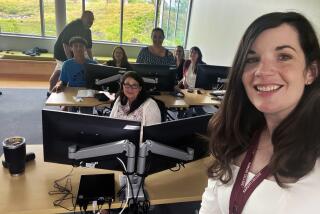A government genealogy service lets family history leap off the page
- Share via
At first glance, the photo-copied documents simply looked like government forms and applications.
But when Susanne Mori read more closely, she found the story of her grandfather’s life as he made his way in America more than five decades ago.
Those 23 pages of facts and dates revealed how a young man, Jinbei Mori, left Japan and arrived in San Francisco the month after the 1906 earthquake, how he spent decades working for the Union Pacific Railroad, how his home was searched by the FBI during World War II.
Mori said seeing her grandfather’s photographs and reading his words brought his immigrant experience to life.
“We are all descendants from immigrants, and at some point our families decided to leave the place they called home for whatever reason and come to someplace new and start over,” said Mori, 52, of Santa Barbara. “Seeing in print the name of a ship and where [my grandfather] was born somehow makes it more real.”
The documents came from U.S. Citizenship and Immigration Services, which runs a little-known genealogy service for relatives wanting to learn more about their family history.
The records include naturalization files, visa applications and citizenship tests, and may reveal family secrets and mysteries, said Marian Smith, the agency’s historian.
“The details of the story have been told over time, and the edges kind of wear off,” Smith said. With the documents, “there are a lot of ah-ha moments.”
In the past, genealogy researchers had to file document requests under the Freedom of Information Act and sometimes waited years for a response.
Under the genealogy program, which started in 2008, requests are usually completed within 90 days. For $20, the government will run a search of the name, as long as the person is deceased. If there are records available, the government charges additional fees for the files.
In fiscal year 2009, more than 5,300 requests were made, fewer than expected. In addition to relatives, historians or researchers can also request files.
Alan Latteri, 34, had a very practical reason for the document search. The Brentwood man wanted dual citizenship with Italy and needed to know exactly when his grandfather was naturalized to complete the complex application. After requesting the documents, Latteri learned that he was not eligible. But he did learn more about his grandfather.
“Reading about him is really interesting,” Latteri said. “I don’t really have a connection to him other than seeing a few photos and hearing a few stories from my dad.”
Mori was just a toddler when her grandfather died, and she wanted to find out more about his life. She heard about the immigration documents during a genealogy class and submitted a request early last year.
Even though she knew some information, the documents completed the picture in her grandfather’s words.
According to the immigration files, Jinbei Mori was born in Okugaita, Japan, on May 25, 1888, and came to the U.S. in May 1906 on the steamship Korea from Hawaii. Soon after, he started working for Union Pacific and became a section foreman. He married and had four sons and a daughter. The family lived in several states, including Wyoming, Idaho and Utah.
During World War II, Mori completed an application listing his height as 5 feet, 3 1/2 inches and his complexion as “yellow.” A photo shows a stern man with a tall forehead who is wearing a dark suit.
In April 1942, the FBI searched his home in Brigham City, Utah, looking for anything prohibited for “enemy aliens of Japanese, German and Italian nationalities.” The agents interviewed his wife, who said her husband had turned in a Spartan shortwave radio to the sheriff’s office.
In 1953, Mori applied for naturalization and took the citizenship test just before Christmas. Though his answers were in Japanese, a notation about the test said, “Apparently OK.” On March 9, 1954, he became a U.S. citizen.
Susanne Mori said the documents confirmed a lot of family stories. She remembered her father talking about making that radio from a kit and how annoyed he was that his father turned it over to authorities. The papers also cleared up some confusion about dates. “What we know about our relatives is what they choose to tell us, and they don’t always tell you the truth,” she said. The files also gave her leads for future research.
“It will be a treasure chest for genealogists,” said Southern California Genealogical Society President Pam Wiedenbeck. “Oftentimes these files will have information on brothers, sisters, aunts and uncles that will help connect the dots.”
For experienced genealogists, the files may open the doors to even more research, perhaps leading people to exact hometowns in their ancestors’ native countries. And for those new to genealogy, they may be just the beginning. “For every question you answer you come up with two or three more,” Wiedenbeck said.
anna.gorman@latimes
For more information about the program, check out www.uscis.gov/genealogy.
More to Read
Sign up for Essential California
The most important California stories and recommendations in your inbox every morning.
You may occasionally receive promotional content from the Los Angeles Times.










